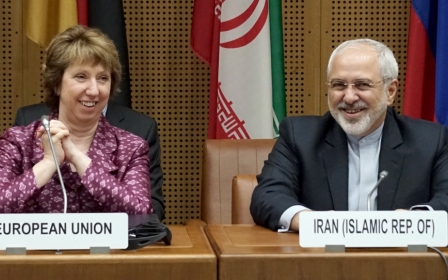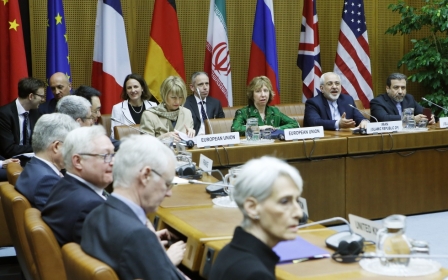Did sanctions push Iran towards a nuclear deal?

High hopes once underpinned the sixth and final round of nuclear talks between Iran and the so-called P5+1, originally due to conclude this month. But while the two sides have likely come closer on the issue of a nuclear Iran than ever before, the talks, at least in their initial intended form, now look close to failure, and it is all but certain that the initial 20 July deadline will not be met.
Iran and the six other countries - The United States, France, Britain, Russia and China plus Germany - have been in talks since late 2013, with Iran seemingly willing to negotiate on a number of key hurdles, some of which have already been overcome. The international community has long espoused that the goodwill created during the talks could lay the foundations for better relations between Iran and lead to reconciliation with the West.
As the talks process falters, analysts and commentators are once again asking, why did Iran agree to start talks in the first place, and what lessons can be learned?
Western media reports and analysts have long contended that Iran was pushed to the negotiating table by a raft of UN and other sanctions that were designed to hit the economy and the country hard.
However, several analysts have argued for years that while Iran’s “economy is hurting,” international sanctions will not deter the country’s nuclear development plans.
A temporary relief of sanctions has shown a rather muted impact on the economy, pushing many experts to conclude that a comprehensive lift of economic embargos alone, will not turn the Iranian economy around.
Furthermore, several analysts point to a change in culture within Iran’s ruling elite, which, they say, has driven the latest rapprochement, and encouraged Iranian policymakers to sit at the negotiating table.
Interim sanctions relief
On 24 November 2013, Iran committed to a six-month period of limited nuclear activity and intrusive UN inspections of its nuclear sites. In return, the P5+1 provided Iran with a temporary and partial lift of sanctions on several of its trade and industrial sectors - including the petrochemical industry, automotive and civil aviation manufacture, and trade in gold and other metals.
While the White House valued the temporary relief of sanctions at around $7bn, some analysts believe the relief has not had any impact on the economy.
“Nothing has been lifted essentially. There have been hopes not facts,” said Kevan Harris, associate director of Iran and Persian studies at Princeton University, about the interim sanctions relief.
Mahmoud Reza Golshanpazhooh, deputy of research at the Tehran International Studies and Research Institute, agrees.
“No tangible change has happened so far,” he told Middle East Eye.
Other observers, however, have seen subtle developments since the interim deal was struck.
“The value of the Iranian riyal against foreign currencies has been stabilised – except for a short period of time when it jumped a little. (There has also been a) flood of foreign tourists,” said Mojtaba Sadeghian, editor of the Tehran Times.
But analysts still believe that these improvements cannot be strictly associated with the temporary sanctions lift. Instead, they link these changes to a “positivity” felt by Iranians and investors, and to an internal economic reform plan that began during the final months of President Mahmoud Ahmadinejad’s term in office.
“A turnaround in the economy – lowering inflation and dealing with government debts - started even before the election of Iranian President Rouhani,” said Harris.
Iran’s current president, Hassan Rouhani, was elected in June 2013, more than six months before the interim deal was agreed upon.
“Most of the effects we see are psychological in nature. It is also difficult to differentiate between these (psychological effects) and the impact of government economic reform measures,” said Golshanpazhooh.
“A lot of this is due to perception. When there is a perception that sanctions will be lifted, the idea or hope of sanctions alleviation drives a turnaround,” he added.
Vulnerable economy
As a reaction to Iran’s pursuit of advanced nuclear technology in 2002, the UN, the US and EU implemented punitive sanctions on Iran in successive stages. The worst of these was in 2011, when the international community placed far-reaching sanctions on Iranian oil exports, and severely curtailed the country’s financial and banking sectors.
With these developments, the country experienced a real shock. Unilateral financial sanctions, coupled with oil embargoes effectively disabled Iran from exporting more than half of what it used to sell, causing a sharp increase in inflation rates and a steep devaluation of the riyal.
Iran has several robust industries – textiles, construction, petrochemicals, among others. But its “economy is vulnerable on two fronts – over-reliance on oil exports, which accounts for 80 percent of foreign currency revenues … (and) a high degree of import dependence for major items, both for feeding the population and for keeping industrial units afloat,” Hasan Hakimian, SOAS lecturer on Iranian studies, told the Guardian after the sanctions were imposed.
The impact of these harsher embargoes was soon felt on the ground.
“The most tangible effects of sanctions on people’s lives have been a runaway increase in the price of essential goods … and a shortage in certain medications,” said Golshanpazhooh.
“Everything became several times more expensive; even the rich were struggling. Many people, including my dad, had to close their businesses down because of high taxes,” said 36 year-old Toktam Amer, a former business owner from Tehran.
By 2013, economic statistics did not look very positive; Iran’s GDP growth was valued at -1.253 percent, while the inflation rate hit 22 percent. Iran was also burdened by huge government debts and unemployment rates reached 13.37 percent.
While it may be clear to analysts that the Iranian economy has deteriorated, it is difficult for many to evaluate the actual extent to which long-term sanctions have contributed to this decline.
“The impact of sanctions in certain fields such as the attraction of foreign direct investment, tourism, oil and gas industries… (and) in bringing many development projects to a standstill because of the severe reduction in government revenue will be only demonstrated after … many years,” said Golshanpazhooh.
It has been even more challenging to differentiate between the effect of international sanctions and the role of internal management policies in regard to Iran’s economic struggles.
“It’s hard to separate out the internal policy effects on economics in Iran and the external sanctions’ effects; they are both combined,” Princeton's Harris told MEE.
“The impact of sanctions was furthered by the corruption and mismanagement of the previous government (Ahmadinejad’s administration),” said Koroush Ziabari, a journalist at the Tehran Times.
This causes some analysts to predict that a gradual lifting of sanctions can only work if it is coupled with wider reform.
“In that sense, if the nuclear talks succeed, the removal of sanctions - which will be very slow - will be equally combined with a plan for reforms,” explained Princeton’s Harris.
Others have even gone as far as expecting little change if sanctions are lifted without a rigorous internal economic reform policy by Rouhani’s administration.
“The economy free of sanctions will be nothing more than what it used to be at the beginning of Ahmadinejad’s time," Sadeghian said. "The so-called resource curse will continue to dominate the economy and the government will be happy to just control inflation. There are no promising signs visible in various sectors of the economy.”
Culture change
With economic and industrial advancement not so clear-cut for a sanctions-free Iran, observers point toward a change in culture among policymakers as an influential factor in Iran’s recent rapprochement.
A prominent reflection of the shift has been Iran’s supreme religious leader and highest authority, Ayatollah Ali Khamenei’s support of the nuclear talks.
Underlying this change has been popular demand for a new government that would adopt a less conservative approach towards both internal affairs and foreign relations, analysts have said.
“There are internal politics which have created an opportunity for the (nuclear) talks to happen. The elections became about (ending) the sanctions, creating broader openness and reversing the previous government’s policies,” said Harris.
“The majority of middle-class Iranians were looking for a moderate government that could repair Iran’s relations with the international community,” said Ziabari. “Without the sanctions, Iran will be able to integrate.”
The earliest manifestation of this was illustrated in the election of Hassan Rouhani in June 2013, a reformist-backed, moderate leader who promised to revitalise Iran’s global image by ushering in a new era of moderate foreign policy.
Rouhani won 50.71 percent of the votes in the presidential elections, replacing conservative Mahmoud Ahmedinijad, who was seen by many Iranians and analysts to have badly managed Iran’s economy and greatly isolated it from the international community.
In September 2013, and after years of hostility between Iran and the west, Rouhani appointed Mohammad Javad Zarif to lead the nuclear talks.
“I am supportive of Rouhani, I think he will change lots of things in Iran. He will resolve international problems with Europeans and Americans, and will give more freedom to women,” Jasmine Eftekhari, a 29-year-old playwright from Isfahan, told MEE.
“We need all sanctions removed, more freedom for women and reduction of tension between Iran and other countries,” said Zohre Yoosefi, a 27-year-old student from Tehran.
But while a culture shift may have driven Iranians to sit at the negotiation table, as talks seemingly halt at yet another hurdle, the P5+1 may need to find alternative means - other than economic sanctions - in order to persuade Iranian policy makers into sealing the deal.
New MEE newsletter: Jerusalem Dispatch
Sign up to get the latest insights and analysis on Israel-Palestine, alongside Turkey Unpacked and other MEE newsletters
Middle East Eye delivers independent and unrivalled coverage and analysis of the Middle East, North Africa and beyond. To learn more about republishing this content and the associated fees, please fill out this form. More about MEE can be found here.



